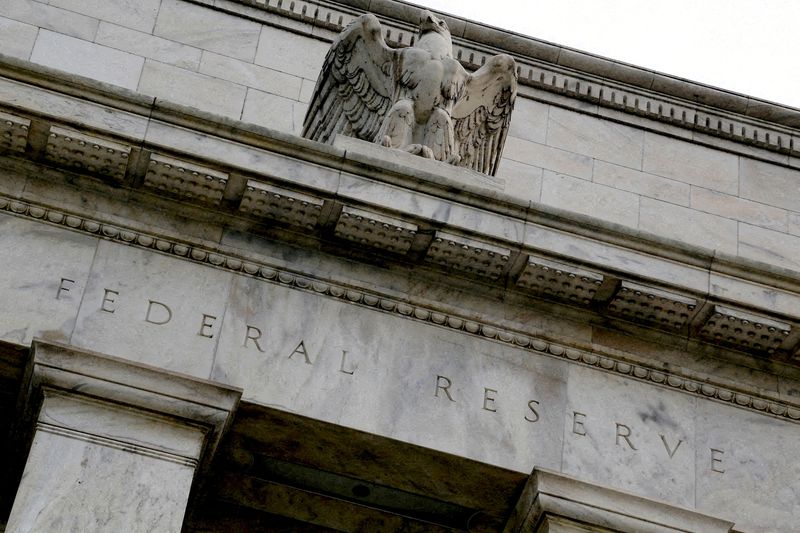Fed says banks can withstand economic downturn, clears way for dividend hikes

By Pete Schroeder and Nupur Anand
WASHINGTON (Reuters) -Twenty-two of the largest banks in the U.S. are well-positioned to weather a hypothetical severe economic downturn and continue lending, with firms maintaining robust capital levels even after suffering hundreds of billions of dollars in losses, the Federal Reserve reported on Friday.
The results of the U.S. central bank’s annual "stress test" of large banks’ finances found firms remain resilient in the face of a potential recession, a spike in unemployment, and market turmoil. The optimistic showing could lead to banks upping how much excess capital they plan to distribute to shareholders via dividends or stock buybacks.
In aggregate, the test found the banks suffered losses of more than $550 billion in the Fed’s scenario, which drove down their capital levels by 1.8 percentage points. But even then, firms retained more than twice the minimum level of capital required by regulations.
On average, the test found banks retained an average 11.6% ratio of their common equity tier 1 capital, well above the 4.5% minimum required.
The results of the annual exam are significant for banks as their performance in the exercise sets the "stress capital buffer" they must hold against potential losses. Those buffers typically are finalized in August, according to Fed officials.
The relatively clean bill of health from the central bank clears the way for the firms to announce capital plans to shareholders as soon as Tuesday after U.S. markets close, Fed officials said.
3rd party Ad. Not an offer or recommendation by Investing.com. See disclosure here or remove ads."This supports ongoing, if not higher buybacks for the banks" given that loan growth has been sluggish and their balance sheets have grown, said Chris Marinac, director of research at Janney Montgomery Scott.
"I also think you’re going to see a strategy from banks where there is more emphasis on buybacks over dividends," he said, noting that banks that underwent stress tests have seen an average 3% decline in outstanding shares over the last five quarters.
Some analysts said the strong results could even drive further bank lending.
"The stress tests have proven that most banks have more than twice the reserve capital required, so there is evidence that they could use this to spur loan growth," said Brian Mulberry, portfolio manager at Zacks Investment Management, which holds banking stocks. "Considering that the U.S. consumer is still strong and the stress test supports their healthy positions, we could see the banks pull some of the capital back and channel it into lending."
Banks generally performed better in the 2025 test than in the 2024 version, in part because the Fed’s test this year was less severe. The stress test runs counter to the overall U.S. economy, so a slightly weaker economy leading up to the test resulted in a slightly less vigorous scenario.
The 2025 test involved a severe global recession that included a 30% decline in commercial real estate prices and a 33% decline in home prices. The unemployment rate spiked 5.9 percentage points to 10% under the test.
3rd party Ad. Not an offer or recommendation by Investing.com. See disclosure here or remove ads.The largest global banks all posted stronger results than in 2024, led by JPMorgan Chase (NYSE:JPM), which retained a capital ratio of 14.2% under the test. The nation’s six largest banks all retained double-digit capital ratios under the test.
The bank that posted the highest capital ratio under the test was Charles Schwab (NYSE:SCHW) at 32.7%. BMO’s U.S. operations posted the lowest capital ratio at 7.8%.
STRESS TEST OVERHAUL
The stress test results were released during a transitory period for the exercise, which was established following the 2008 financial crisis to probe big banks’ resilience. The Fed announced at the end of 2024 that it would be pursuing major changes to how the test is conducted, largely responding to industry complaints that the exercise is opaque and subjective.
Among the changes, the Fed proposed in April that the results should be averaged over two years, in response to complaints about volatility. That rule-writing project is still ongoing, but the central bank said on Friday that if the 2025 and 2024 results were averaged, the bank capital decline would increase to 2.3 percentage points.
If the Fed is able to complete that rule-writing this year, the average results will be used to set the stress capital buffer beginning in the first quarter of 2026, officials said.
In addition to averaging results, the Fed has said it also plans to make the scenarios it concocts and the models it uses to produce results available to the public and will be soliciting public feedback on them.
3rd party Ad. Not an offer or recommendation by Investing.com. See disclosure here or remove ads.Bank Stress Test
Capital Ratio 2025
(in %)
JPMorgan Chase 14.2
Bank of America 10.2
Citigroup (NYSE:C) 10.4
Wells Fargo 10.1
Goldman Sachs 12.3
Morgan Stanley 12.2
Source: Federal Reserve
Should you invest $2,000 in C right now?Before you buy stock in C, consider this: ProPicks AI are 6 easy-to-follow model portfolios created by Investing.com for building wealth by identifying winning stocks and letting them run. Over 150,000 paying members trust ProPicks to find new stocks to buy – driven by AI. The ProPicks AI algorithm has just identified the best stocks for investors to buy now. The stocks that made the cut could produce enormous returns in the coming years. Is C one of them?
Reveal Undervalued Stocks Now